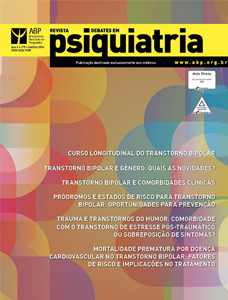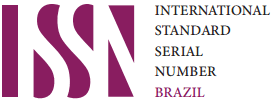Transtorno bipolar e gênero: quais as novidades?
DOI:
https://doi.org/10.25118/2236-918X-6-5-2Palabras clave:
Transtorno bipolar, gênero, diferenças, mulherResumen
Este artigo resume as pesquisas entre 2014 e 2016 pertinentes às diferenças em cuidados clínicos e neurobiologia de mulheres e homens com transtorno afetivo bipolar (TAB). Com TAB, o sexo feminino se correlaciona com mais sintomas depressivos e diferentes comorbidades. As mulheres também têm um maior grau de episódios mistos e ciclagem rápida. Quanto a comorbidades, doença da tireoide, obesidade e transtornos de ansiedade ocorrem mais frequentemente em mulheres, enquanto transtornos por uso de substância são mais comuns em homens. O exercício aumenta os níveis do fator neurotrófico derivado do cérebro em mulheres bipolares, mas não em homens. Pacientes do sexo masculino e do sexo feminino têm biomarcadores distintos para o TAB. Alterações menstruais e flutuação de humor estão presentes em mulheres tratadas para o TAB em um grau maior do que nos controles. Lamotrigina pode ser útil para atenuar essa flutuação. A desregulação da tireoide associada ao lítio ocorre mais frequentemente em pacientes do sexo feminino. Homens e mulheres com TAB recebem tratamentos diferentes em ambientes clínicos de rotina. Decisões clínicas de tratamento são, em certa medida, indevidamente influenciadas pelo sexo dos pacientes.
Descargas
Métricas
Citas
Miller LJ, Ghadiali NY, Larusso EM, Wahlen KJ, Avni-Barron O, Mitt al L, et al. Bipolar disorder in women. Health Care Women Int. 2015;36:475-98. https://doi.org/10.1080/07399332.2014.962138
Parial S. Bipolar disorder in women. Indian J Psychiatry. 2015;57:S252-63. https://doi.org/10.4103/0019-5545.161488
Reynolds-May MF, Kenna HA, Marsh W, Stemmle PG, Wang P, Kett er TA, et al. Evaluati on of reproductive function in women treated for bipolar disorder compared to healthy controls. Bipolar Disord. 2014;16:37-47. https://doi.org/10.1111/bdi.12149
Schuch FB, da Silveira LE, de Zeni TC, da Silva DP, Wollenhaupt-Aguiar B, Ferrari P, et al. Eff ects of a single bout of maximal aerobic exercise on BDNF in bipolar disorder: a gender-based response. Psychiatry Res. 2015;229:57-62. https://doi.org/10.1016/j.psychres.2015.07.072
Becking K, Spijker AT, Hoencamp E, Penninx BW, Schoevers RA, Boschloo L. Disturbances in hypothalamic-pituitary-adrenalaxis and immunological activity different iating between unipolar and bipolar depressive episodes. PLoS One. 2015;10:e0133898. https://doi.org/10.1371/journal.pone.0133898
Chen JJ, Huang H, Zhao LB, Zhou DZ, Yang YT, Zheng P, et al. Sex-specific urinary biomarkers for diagnosing bipolar disorder. PLoS One. 2014;9:e115221. https://doi.org/10.1371/journal.pone.0115221
Kaplan KJ, Harrow M, Clews K. The twentyyear trajectory of suicidal activity among posthospital psychiatric men and women with mood disorders and schizophrenia. Arch Suicide Res. 2016;20:336-48. https://doi.org/10.1080/13811118.2015.1033505
Tidemalm D, Haglund A, Karanti A, Landén M, Runeson B. Att empted suicide in bipolar disorder: risk factors in a cohort of 6086 patients. PLoS One. 2014;9:e94097. https://doi.org/10.1371/journal.pone.0094097
Tondo L, Pompili M, Forte A, Baldessarini RJ. Suicide attempts in bipolar disorders: comprehensive review of 101 reports. Acta Psychiatr Scand. 2016;133:174-86. https://doi.org/10.1111/acps.12517
Parker G, Fletcher K, Paterson A, Anderson J, Hong M. Gender differences in depression severity and symptoms across depressive sub-types. J Aff ect Disord. 2014;167:351-7. https://doi.org/10.1016/j.jad.2014.06.018
Vázquez GH, Baldessarini RJ, Tondo L. Cooccurrence of anxiety and bipolar disorders: clinical and therapeutic overview. Depress Anxiety. 2014;31:196-206. https://doi.org/10.1002/da.22248
Poletti S, Colombo C, Benedetti F. Adverse childhood experiences worsen cognitive distortion during adult bipolar depression. Compr Psychiatry. 2014;55:1803-8. https://doi.org/10.1016/j.comppsych.2014.07.013
Wu SI, Chen SC, Liu SI, Sun FJ, Juang JJ, Lee HC, et al. Relative risk of acute myocardial infarction in people with schizophrenia and bipolar disorder: a population-based cohort study. PLoS One. 2015;10:e0134763. https://doi.org/10.1371/journal.pone.0134763
Birner A, Seiler S, Lackner N, Bengesser SA, Queissner R, Fellendorf FT, et al. Cerebral white matter lesions and affective episodes correlate in male individuals with bipolar disorder. PLoS One. 2015;10:e0135313. https://doi.org/10.1371/journal.pone.0135313
Saunders EF, Fernandez-Mendoza J, Kamali M, Assari S, McInnis MG. The effect of poor sleep quality on mood outcome differs between men and women: a longitudinal study of bipolar disorder. J Aff ect Disord. 2015;180:90-6. https://doi.org/10.1016/j.jad.2015.03.048
Erol A, Winham SJ, McElroy SL, Frye MA, Prieto ML, Cuellar-Barboza AB, et al. Sex differences in the risk of rapid cycling and other indicators of adverse illness course in patients with bipolar I and II disorder. Bipolar Disord. 2015;17:670-6. https://doi.org/10.1111/bdi.12329
Miller S, Suppes T, Mintz J, Hellemann G, Frye MA, McElroy SL, et al. Mixed depression in bipolar disorder: prevalence rate and clinical correlates during naturalistic follow-up in the Stanley bipolar network. Am J Psychiatry. 2016 Apr 15:appiajp201615091119. [Epub ahead of print] https://doi.org/10.1176/appi.ajp.2016.15091119
Sharma V, Xie B, Campbell MK, Penava D, Hampson E, Mazmanian D, et al. A prospective study of diagnostic conversion of major depressive disorder to bipolar disorder in pregnancy and postpartum. Bipolar Disord. 2014;16:16-21. https://doi.org/10.1111/bdi.12140
Karanti A, Bobeck C, Osterman M, Kardell M, Tidemalm D, Runeson B, et al. Gender differences in the treatment of patients with bipolar disorder: a study of 7354 patients. J Affect Disord. 2015;174:303-9. https://doi.org/10.1016/j.jad.2014.11.058
Robakis TK, Holtzman J, Stemmle PG, Reynolds-May MF, Kenna HA, Rasgon NL. Lamotrigine and GABAA receptor modulators interact with menstrual cycle phase and oral contraceptives to regulate mood in women with bipolar disorder. J Affect Disord. 2015;175:108-15. https://doi.org/10.1016/j.jad.2014.12.040
Weinstock LM, Gaudiano BA, Epstein-Lubow G, Tezanos K, Celis-Dehoyos CE, Miller IW. Medication burden in bipolar disorder: a chart review of patients at psychiatric hospital admission. Psychiatry Res. 2014;216:24-30. https://doi.org/10.1016/j.psychres.2014.01.038
Stamm TJ, Lewitzka U, Sauer C, Pilhatsch M, Smolka MN, Koeberle U, et al. Supraphysiologic doses of levothyroxine as adjuncti ve therapy in bipolar depression: a randomized, double-blind, placebo-controlled study. J Clin Psychiatry. 2014;75:162-8.
https://doi.org/10.4088/JCP.12m08305
Özerdem A, Tunca Z, Çımrın D, Hıdıroğlu C, Ergör G. Female vulnerability for thyroid function abnormality in bipolar disorder: role of lithium treatment. Bipolar Disord. 2014;16:72-82. https://doi.org/10.1111/bdi.12163
Zhang L, Li H, Li S, Zou X. Reproductive and metabolic abnormalities in women taking valproate for bipolar disorder: a meta-analysis. Eur J Obstet Gynecol Reprod Biol. 2016;202:26-31. https://doi.org/10.1016/j.ejogrb.2016.04.038
Shine B, McKnight RF, Leaver L, Geddes JR. Long-term effects of lithium on renal, thyroid, and parathyroid functi on: a retrospective analysis of laboratory data. Lancet. 2015;386:461-8.
https://doi.org/10.1016/S0140-6736(14)61842-0
Baskaran A, Cha DS, Powell AM, Jalil D, McIntyre RS. Sex differences in rates of obesity in bipolar disorder: postulated mechanisms. Bipolar Disord. 2014;16:83-92. https://doi.org/10.1111/bdi.12141
Godin O, Etain B, Henry C, Bougerol T, Courtet P, Mayliss L, et al. Metabolic syndrome in a French cohort of patients with bipolar disorder: results from the FACE-BD cohort. J Clin Psychiatry. 2014;75:1078-85. https://doi.org/10.4088/JCP.14m09038
Charlott e M, Schwartz E, Slade E, Medoff D, Li L, Dixon L, et al. Gender differences in mood stabilizer medications prescribed to Veterans with serious mental illness. J Affect Disord. 2015;188:112-7. https://doi.org/10.1016/j.jad.2015.08.065
Descargas
Publicado
Cómo citar
Número
Sección
Licencia

Esta obra está bajo una licencia internacional Creative Commons Atribución-NoComercial 4.0.
Debates em Psiquiatria permite que el (los) autor (es) mantenga(n) sus derechos de autor sin restricciones. Permite al (los) autor (es) conservar sus derechos de publicación sin restricciones. Los autores deben garantizar que el artículo es un trabajo original sin fabricación, fraude o plagio; no infringe ningún derecho de autor o derecho de propiedad de terceros. Los autores también deben garantizar que cada uno atendió a los requisitos de autoría conforme a la recomendación del ICMJE y entienden que, si el artículo o parte de él es fallido o fraudulento, cada autor comparte la responsabilidad.
Reconocimiento-NoComercial 4.0 internacional (CC BY-NC 4.0) - Debates em Psiquiatria es regida por la licencia CC-BY-NC
Usted es libre de:
- Compartir — copiar y redistribuir el material en cualquier medio o formato
- Adaptar — remezclar, transformar y crear a partir del material
El licenciador no puede revocar estas libertades mientras cumpla con los términos de la licencia. Bajo las condiciones siguientes:
- Reconocimiento — Debe reconocer adecuadamente la autoría, proporcionar un enlace a la licencia e indicar si se han realizado cambios<. Puede hacerlo de cualquier manera razonable, pero no de una manera que sugiera que tiene el apoyo del licenciador o lo recibe por el uso que hace.
- NoComercial — No puede utilizar el material para una finalidad comercial.
No hay restricciones adicionales — No puede aplicar términos legales o medidas tecnológicas que legalmente restrinjan realizar aquello que la licencia permite.






























